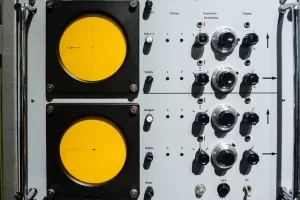
What is An Oscillator?
November 29 2023  1285
1285
Inquiry
Global electronic component supplier AMPHEO PTY LTD: Rich inventory for one-stop shopping. Inquire easily, and receive fast, customized solutions and quotes.
QUICK RFQ
ADD TO RFQ LIST
In this blog, the basics of oscillators will be discussed.
What is An Oscillator?

Oscillator with Transistors

Oscillator vs Inverter
An oscillator and an inverter are both fundamental components in electronics, but they serve different purposes and operate in distinct ways. An oscillator is a circuit that generates a periodic electronic signal, while an inverter is a logic gate that produces the complement (opposite) of its input signal. Let's delve into the differences between these two components. An oscillator is designed to produce a continuous output signal with a specific frequency and waveform, such as a sine wave, square wave, or sawtooth wave. It achieves this through positive feedback within the circuit, allowing it to sustain oscillation at the desired frequency. Oscillators are widely used in applications that require a stable and controllable signal source, such as radio frequency (RF) communication systems, audio signal generation, and clock signal generation for digital systems. On the other hand, an inverter is a digital logic gate that performs the logical operation of negation. It takes an input signal and produces the logical complement of that signal at its output. Inverters are essential building blocks in digital circuits, where they are used to perform tasks such as signal inversion, logic level conversion, and the implementation of various digital logic functions. While both oscillators and inverters involve the use of electronic components, their functions and applications are distinct. Oscillators are primarily used to generate periodic waveforms at specific frequencies, while inverters are used for digital signal processing and logic operations in digital circuits. In summary, oscillators and inverters are essential components in electronics, each serving a unique purpose. Oscillators are employed to produce continuous periodic signals, while inverters are used for digital logic operations and signal processing. Understanding the differences between these components is crucial for designing and implementing electronic systems and circuits for a wide range of applications.How Oscillator Work?
An oscillator works by converting direct current (DC) power into an alternating current (AC) signal with a specific frequency and waveform. This process is achieved through the use of an electronic circuit that provides positive feedback to sustain oscillation. Let's explore the fundamental principles of how an oscillator works. At the heart of an oscillator is a feedback loop that allows a portion of the output signal to be fed back to the input of the circuit. This feedback, when combined with amplification provided by active components such as transistors or operational amplifiers, enables the circuit to generate and maintain oscillations. The feedback loop ensures that a portion of the output signal is continuously reintroduced to the input, reinforcing the oscillations and allowing the circuit to produce a sustained AC output. The frequency of the oscillations produced by the circuit is determined by the characteristics of the feedback network and the active components within the oscillator. The feedback network, which typically includes resistors, capacitors, and inductors, is carefully designed to provide the appropriate phase shift and gain at the desired frequency, allowing the circuit to achieve stable oscillations. In addition to the feedback network, the biasing and operating conditions of the active components play a crucial role in the functioning of an oscillator. For example, in a transistor-based oscillator, the transistor is biased to operate in its active region, allowing it to amplify the input signal and sustain the oscillations. Similarly, in an operational amplifier-based oscillator, the operational amplifier is configured to provide the necessary gain and phase shift for oscillation. In summary, an oscillator works by utilizing positive feedback within an electronic circuit to generate and sustain oscillations, producing a continuous AC output signal with a specific frequency and waveform. The careful design of the feedback network, along with the proper biasing and operating conditions of the active components, enables the oscillator to function as a stable and controllable signal source for a wide range of electronic applications.Applications of Oscillators
Oscillators find widespread applications across various fields due to their ability to generate stable and controllable periodic signals. These applications span multiple industries, including telecommunications, electronics, instrumentation, and more. Let's explore some of the key applications of oscillators. In the field of telecommunications, oscillators are essential for generating carrier signals in radio frequency (RF) communication systems. These carrier signals serve as the basis for transmitting information over the airwaves, enabling wireless communication through devices such as mobile phones, Wi-Fi routers, and satellite communication systems. Oscillators are also used in modulators and demodulators to encode and decode information onto carrier signals for transmission and reception. Oscillators play a crucial role in audio signal generation and processing. In electronic musical instruments, oscillators are used to produce sound waves of specific frequencies, allowing musicians to create musical tones and effects. Additionally, oscillators are employed in audio synthesizers, tone generators, and signal generators for testing and measurement purposes in audio equipment design and production. Within digital systems, oscillators are utilized for clock signal generation, ensuring synchronized operation of various components within computers, microcontrollers, and digital signal processing (DSP) systems. The clock signal provided by an oscillator dictates the timing and sequencing of operations within digital circuits, enabling the proper execution of instructions and data processing. Oscillators are also employed in scientific and industrial instrumentation for tasks such as frequency synthesis, signal modulation, and timing control. They are used in precision measurement equipment, such as frequency counters and spectrum analyzers, as well as in scientific research instruments for generating stable reference signals and test waveforms. Furthermore, oscillators are integral to the functioning of electronic control systems, where they provide timing and synchronization signals for processes such as motor control, power conversion, and data communication. In these applications, oscillators ensure the precise timing and coordination of operations, contributing to the efficiency and reliability of electronic control systems.
Conclusion
In summary, oscillators have diverse applications across telecommunications, audio signal processing, digital systems, instrumentation, and electronic control systems. Their ability to generate stable and controllable periodic signals makes them indispensable in numerous electronic devices and systems, contributing to the functionality and performance of a wide range of applications.Populer Posts
ME20A1503C01
Advanced Energy
ZVC150NP36D
EOS Power
SPU50A-4
Astrodyne TDI
ES25B24-P1J
MEAN WELL
PW172KB1803N01
Advanced Energy
WM-M036-480I-C-SUSB
Autec
HES18-069230-2
HiTRON Electronics
WMSAW909-U
Wall Industries
1814913
FRIWO Gerätebau GmbH
MW125XA0303_01
Advanced Energy
MW173KB2403B01
Advanced Energy
HES18-200090-7
HiTRON Electronics
